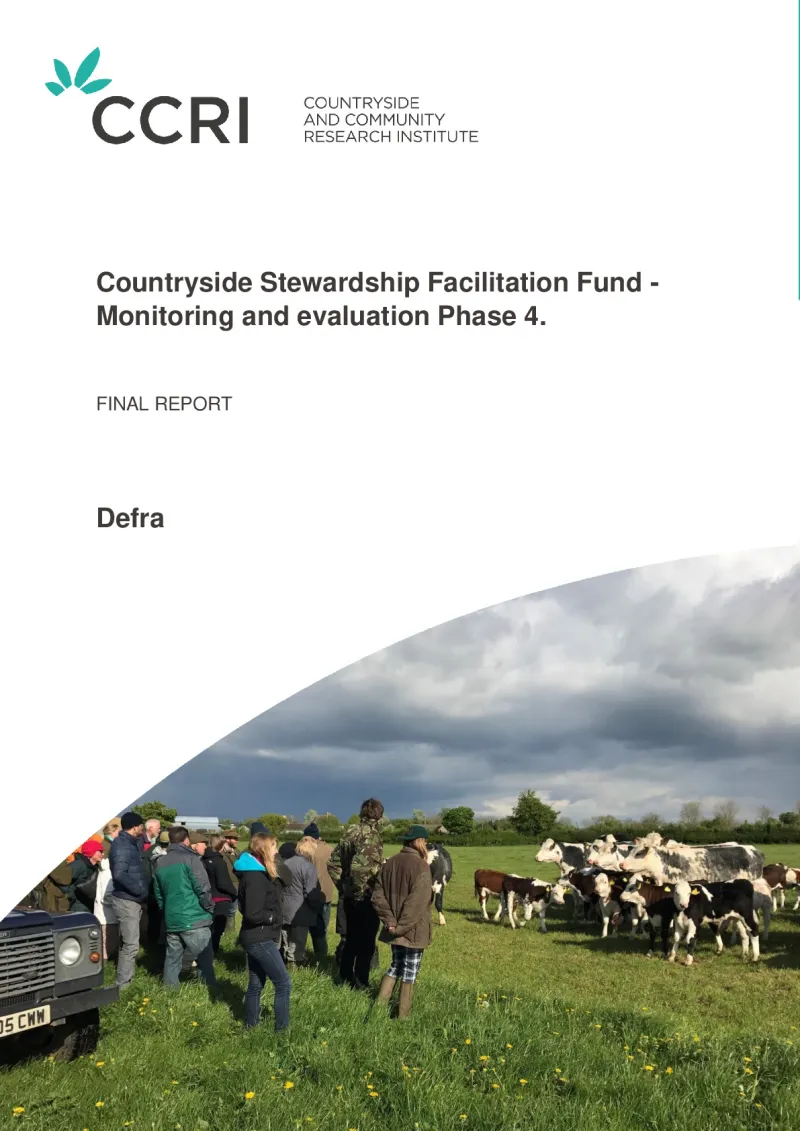Countryside Stewardship Facilitation Fund: monitoring and evaluation phase
The evaluation aims to assess the impact of the Countryside Stewardship Facilitation Fund of England on landscape-scale habitat recovery and collaboration among land managers.
- Other
- 2014-2022
- Environmental impacts


This final report evaluates Phase 4 of the Countryside Stewardship Facilitation Fund (CSFF), which covers 2019 to 2021. Defra’s Countryside Stewardship (CS) was launched in March 2015 and initially administered by Natural England (NE). However, it has been handled by the Rural Payments Agency (RPA) since 2018. The CSFF provides funding at the landscape scale for individuals or organisations to bring farmers, foresters and other land managers together to increase their knowledge and awareness and align delivery with environmental priorities.
This fourth phase seeks to apply the monitoring and evaluation framework to include the groups that started in 2020, to review and update the spatial analysis of what the current CS agreements within CSFF groups are achieving, and to identify the gaps in and around each group to highlight opportunities for expansion or group creation in that area. It also aims to capture some of the narratives from experience with regard to the benefits (or not) of being part of a group, together with an assessment of the use of technological aids and how these have helped or hindered the progress of groups’ ambitions and the well-being of their members. The objectives were:
- Map the spatial coherence of all CSFF groups and test their potential to restore and create habitat at scale in line with current nature recovery ambitions.
- Test to see if incidences of non-compliance are lower in CSFF groups than those areas which do not have a CSFF group.
- Assess if being part of a CSFF group helps maintain resilience and well-being among group members.
- Review how CSFF groups used technology in terms of support and collaboration, and what this means for the future.
The methodology of the study was divided into four key tasks. The first task, mapping spatial coherence and habitat recovery, involved creating a spatial dataset of land managed by CSFF group members and identifying areas under CS and Environmental Stewardship (ES) agreements. This data was analysed to assess changes in group membership and contributions to habitat recovery using Natural Capital Indicators (NCIs).
In the second task, the incidence of non-compliance, the study examined whether CSFF group members showed better compliance with regulations than non-members. It analysed inspection reports from the RPA to identify the frequency and causes of non-compliance.
The third task, resilience and well-being, assessed the impact of CSFF membership on social resilience and well-being, particularly in response to challenges like COVID-19. This involved an online survey of 69 members and telephone interviews with 18, and responses were analysed for qualitative and quantitative insights.
The final task, ‘Use of Technology’, explored how CSFF facilitators used digital tools to support collaboration and management. Data from 41 online surveys and 19 telephone interviews with facilitators highlighted the role of technology, such as Zoom and GIS tools, in facilitating communication and operations.
The study relied on spatial datasets from NE, RPA inspection data and survey responses from CSFF members and facilitators.
Data inconsistencies presented challenges, particularly in member identification. Identifiers like the single business identifier (SBI) were effective in most cases, but large organisations complicated the data with a single SBI covering multiple holdings. Duplications and missing data required manual correction, and datasets were not always up to date.
The study shows that 84% of members are engaged in agri-environment schemes (AES), with 61% of their land managed sustainably, exceeding Defra's target. There is considerable variation in the geographical and environmental coverage of CSFF groups. Certain areas, like grassland and upland habitats, have better group representation than others, such as coastal and wetland areas. The spatial analysis revealed disparities in CSFF group presence across different environmental geographies, including priority habitats, nature improvement areas and protected landscapes. This suggests the need for further expansion or linking existing groups to address gaps in environmental coverage.
CSFF groups remained active during the COVID-19 pandemic. Many members found the group important for access to advice, support and agricultural policy updates. Communication within groups was frequent, especially regarding knowledge sharing on environmental management. However, due to their relative youth, some groups faced challenges adapting to new topics like climate change.
Technology usage has grown among CSFF groups, particularly online tools. However, facilitators still rely on traditional communication methods, such as phone calls and letters, for members without internet access. GIS tools, especially MAGIC, remain central to completing CS applications. Connectivity issues were identified as barriers to wider use of technology. Facilitators expressed support for creating a collaboration hub to enhance interaction between facilitators and integrate with future schemes like environmental land management.
Author(s)
Short C, Breyer J, James N, Morse A, Raseta S, Lewis N, Mills J, Grant M, Yandell-Thomas M and Medcalf K